Overview
Healthcare providers often face emotional challenges that can impact their ability to deliver the best patient care. The administrative burdens they carry can feel overwhelming, detracting from the meaningful interactions they wish to have with their patients. How can we ease this burden?
Virtual physician scribes offer a compassionate solution. These AI-driven assistants enhance documentation accuracy and significantly reduce administrative tasks. By streamlining workflows, they allow healthcare professionals to dedicate more time to patient care, fostering a nurturing and efficient healthcare environment.
The benefits are clear: improved patient interactions lead to higher care quality and greater job satisfaction. Imagine a workplace where you can focus on what truly matters—your patients. Embracing this technology not only supports your well-being but also enriches the lives of those you care for. Let's explore how virtual scribes can transform your practice and enhance your connection with patients.
Introduction
In today's healthcare landscape, many providers are feeling overwhelmed by the weight of administrative tasks. This burden not only consumes precious time but also detracts from the quality of patient interactions. Imagine a world where healthcare providers can refocus on what truly matters: delivering compassionate care to their patients.
The introduction of virtual physician scribes presents a transformative solution. These AI-driven assistants help alleviate the paperwork load, allowing healthcare professionals to engage more meaningfully with their patients. What if these scribes could reshape the future of healthcare by enhancing both efficiency and empathy in patient care?
As we embrace this technology, it's essential to consider its impact on traditional healthcare delivery dynamics. While the benefits are promising, there are still challenges to address to ensure effective integration. How can we navigate these changes together to foster a more supportive environment for both providers and patients?
Virtual scribes could be a key part of this evolution, but we must remain vigilant in understanding their role. Let’s explore how these innovative tools can bring about a brighter future for healthcare, one where compassion and care take center stage.
CosmaNeura: Transforming Healthcare with AI-Driven Administrative Efficiency
Healthcare providers often face overwhelming administrative burdens that can detract from their primary mission: caring for patients. CosmaNeura understands these emotional challenges and leverages advanced AI technology to alleviate them. By automating essential processes such as client intake and triage, virtual physician scribes help the platform significantly reduce the time clinicians spend on paperwork. This allows them to dedicate more attention to those they care for, fostering .
Imagine a world where healthcare professionals can focus solely on their patients, free from the weight of administrative tasks. CosmaNeura makes this a reality by streamlining workflows and enhancing productivity through features like real-time data entry and intelligent scheduling. This shift not only enhances operational efficiency but also addresses the resistance to innovation often felt among service providers concerned about maintaining quality care.
In alignment with the ethical principles of Catholic teachings, CosmaNeura ensures that care remains compassionate and centered on the needs of individuals. The importance of AI in enhancing administrative efficiency is underscored by studies indicating that medical organizations can recover significant hours previously lost to routine tasks. This recovery ultimately leads to improved financial efficiency.
Moreover, virtual physician scribes as AI-driven solutions have proven capable of minimizing errors and enhancing documentation precision, resulting in better outcomes for individuals. As medical leaders recognize the vital role of AI in reducing practitioner workloads and improving in-person interactions, the incorporation of virtual physician scribes becomes essential for contemporary medical service delivery.
Consider the possibilities that lie ahead. By embracing these innovative solutions, healthcare providers can reclaim their time and enhance the quality of care they deliver. Let’s move forward together, prioritizing compassion and efficiency in every aspect of patient care.

Enhanced Documentation: How Virtual Physician Scribes Improve Accuracy and Reduce Workload
In the demanding world of healthcare, the emotional challenges faced by providers can be overwhelming. Virtual physician scribes provide a compassionate solution, significantly improving documentation precision through and summarization during client interactions. This innovative technology captures all pertinent information without distracting clinicians, allowing for more accurate medical records.
By automating labor-intensive administrative duties like charting and appointment scheduling, studies suggest that medical professionals can save up to an hour each day by utilizing virtual physician scribes and AI transcription tools. Imagine being able to devote that time to engaging with your patients—71% of individuals reported spending more time conversing with their doctor because of the AI assistant, highlighting its positive impact on engagement and satisfaction.
Reducing the documentation load through the use of virtual physician scribes empowers medical professionals to concentrate on delivering high-quality care, ultimately enhancing outcomes for those receiving treatment. Dr. William Choo emphasizes that AI transcription not only aids in knowledge transfer but also helps close communication gaps, fostering better understanding and confidence in care plans.
Moreover, the adaptability of AI transcription across specialties and its seamless integration into EHR systems reinforce its reliability and versatility. Importantly, the use of virtual physician scribes also alleviates physician exhaustion, allowing healthcare professionals to focus on what truly matters—their patients. This transformation in healthcare delivery significantly improves the overall experience for those receiving care.
As we navigate the evolving landscape of healthcare, embracing these supportive technologies can lead to a more nurturing environment for both providers and patients. How might your practice benefit from integrating virtual medical assistants into your workflow?

Billing Optimization: The Financial Advantages of Implementing Virtual Physician Scribes
The introduction of virtual physician scribes can significantly enhance billing processes, which is a concern that many healthcare providers face. These dedicated virtual physician scribes assist in recommending precise billing codes during client appointments, ensuring that practitioners can fully realize their billing potential.
Have you ever felt overwhelmed by administrative tasks that take time away from patient care? Retrospective billing analysis can reveal missed opportunities for revenue recovery, ultimately contributing to the financial well-being of healthcare practices. This financial benefit not only alleviates stress but also enables healthcare professionals to reinvest in patient care, enhancing the overall service delivery.
Together, we can create a more for both providers and patients.
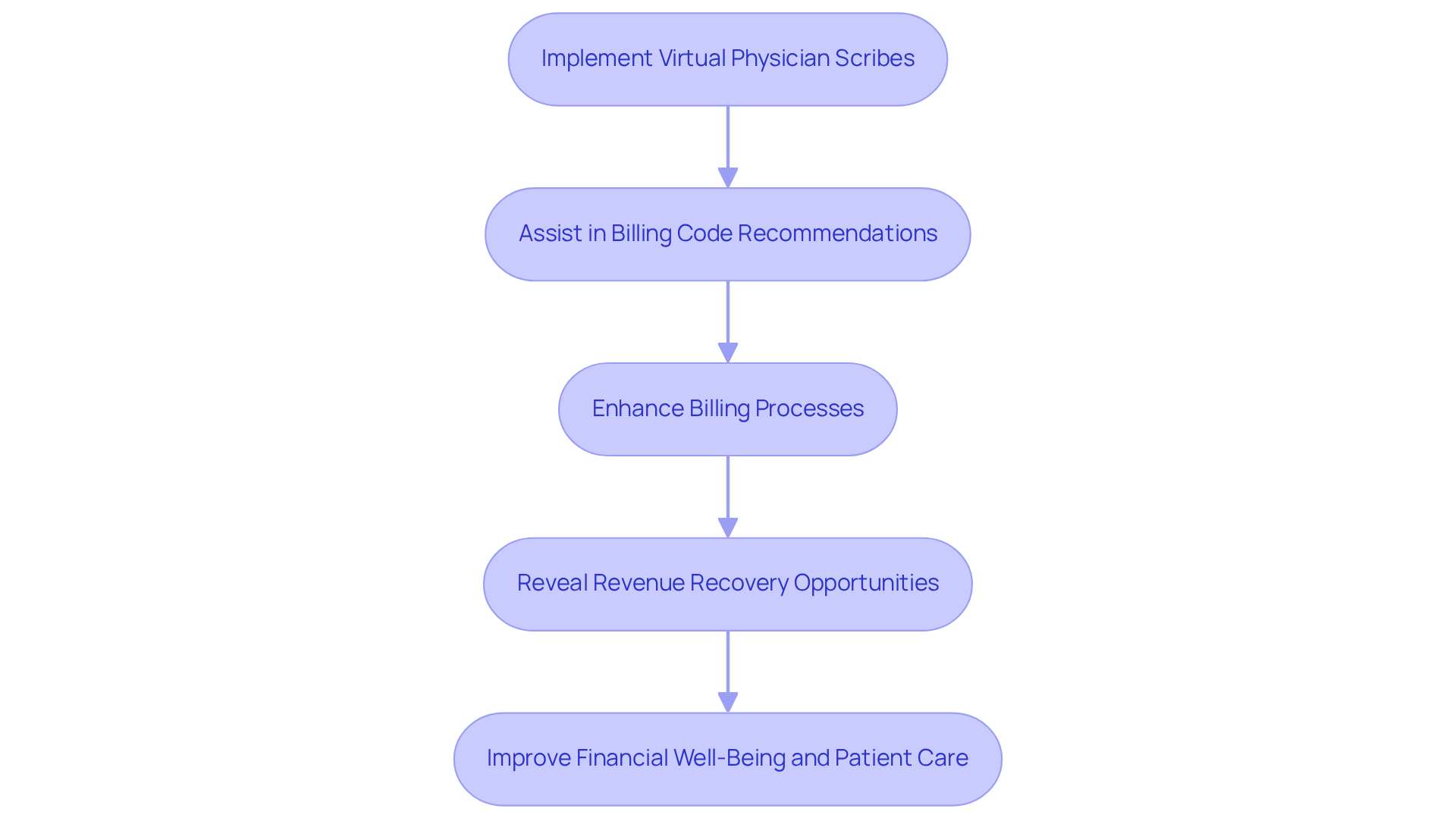
Telehealth Support: The Role of Virtual Scribes in Enhancing Remote Patient Care
In the realm of telehealth, virtual physician scribes play a vital role. They provide real-time documentation and support during remote consultations, alleviating some of the emotional burdens healthcare professionals face. Imagine being able to focus on patient care without the overwhelming weight of administrative tasks. This is where virtual physician scribes shine, allowing providers to deliver while enhancing the experience for clients.
By streamlining the documentation process, these assistants foster improved communication and engagement. For instance, research indicates that:
- 84% of doctors have experienced better communication through the use of AI assistants.
- 56% of individuals reported a positive impact on the quality of their appointments.
Isn’t it reassuring to know that technology can bridge gaps in care?
During a pilot initiative, over 3,400 doctors utilized AI documentation technology in more than 300,000 client encounters. This impressive statistic highlights the efficacy of virtual physician scribes in reducing physician workload and enhancing interactions with individuals. As medical services evolve, the integration of virtual physician scribes will be crucial in enhancing telehealth offerings and ensuring client satisfaction.
Let’s embrace this change together. By incorporating virtual assistants into our practices, we can nurture a more supportive healthcare environment for both providers and clients alike.
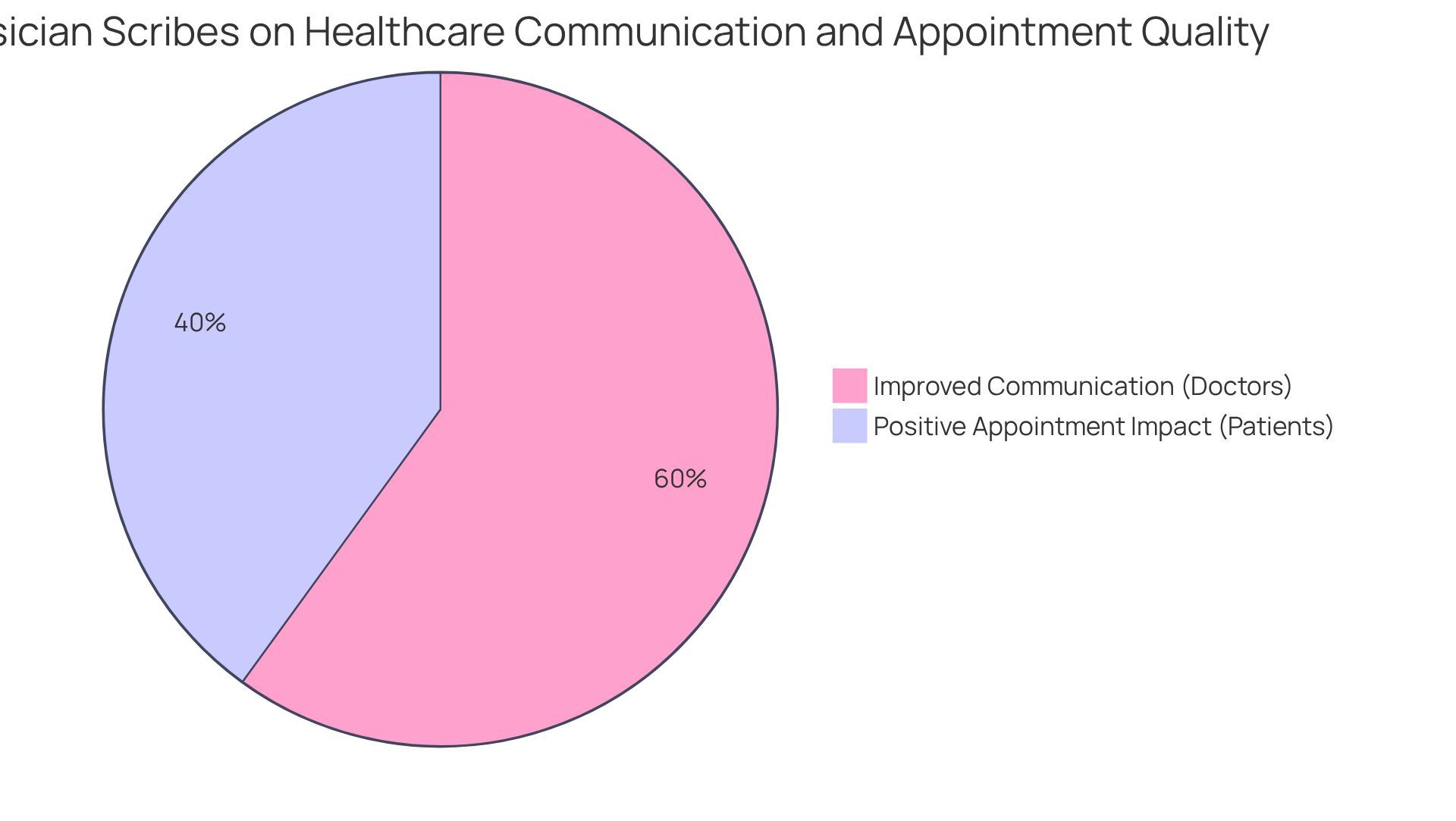
Clinician Training: Ensuring Effective Use of Virtual Physician Scribes in Practice
Healthcare providers often face emotional challenges due to administrative burdens that can impact patient care. To address these concerns, it is essential to participate in for virtual physician scribes. These programs should encompass not only the operational mechanics of the technology but also best practices for integrating note-takers into interactions with individuals. By equipping healthcare professionals with the necessary skills and knowledge, practices can significantly enhance efficiency while upholding high standards of care.
Effective training enables providers to leverage the capabilities of virtual assistants, such as automated documentation systems and AI-driven communication platforms. This not only enhances documentation quality but also reduces administrative burdens, ultimately leading to an improved patient experience. Research has shown that medical assistants can decrease physician burnout by as much as 50%. This statistic underscores the importance of adequate training to realize these benefits.
Moreover, incorporating insights from seasoned writers during training can further enrich the integration process. Shadowing has proven effective in mastering medical terminology and adapting to various documentation styles. By addressing these training challenges, medical professionals can enhance their readiness for the effective deployment of virtual physician scribes. This shift can revolutionize care through increased efficiency and deeper involvement, fostering a more compassionate healthcare environment.
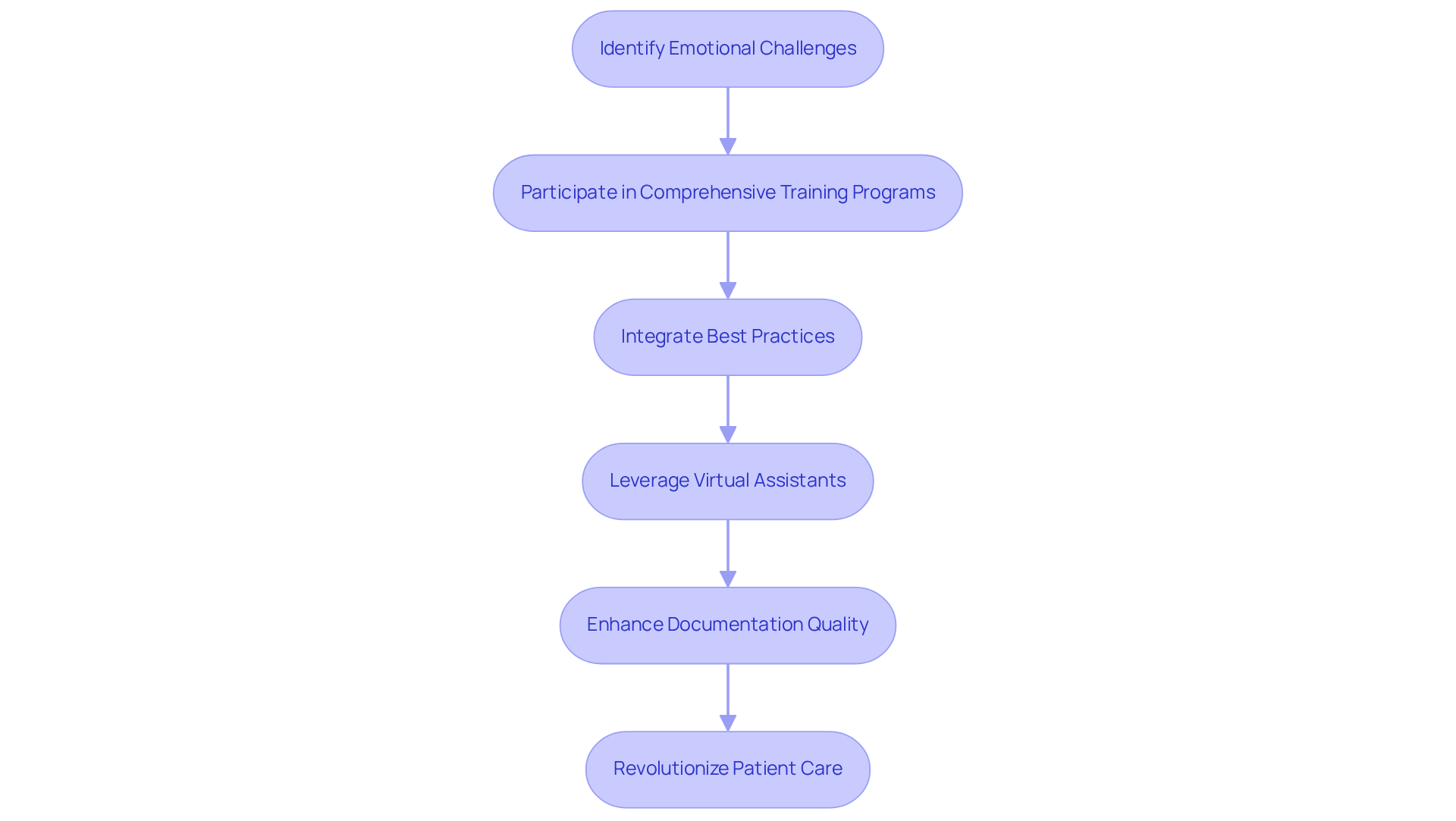
Improved Job Satisfaction: How Virtual Scribes Alleviate Burnout Among Healthcare Providers
Healthcare professionals often face overwhelming administrative burdens that can detract from their passion for patient care. By decreasing this load, the use of virtual physician scribes can significantly enhance the quality of care and elevate job satisfaction. Imagine regaining precious time that was once consumed by documentation—time that can now be devoted to meaningful interactions with clients.
This shift not only nurtures the wellbeing of clinicians but also cultivates a more positive work environment. When healthcare providers feel supported, it ultimately benefits both them and the patients they serve. With , virtual assistants are stepping in to tackle the widespread challenges in healthcare delivery, promoting both administrative efficiency and ethical practices.
Consider the impact of these changes: a more compassionate approach to care, where providers can focus on what truly matters—connecting with their patients. Embracing virtual physician scribes could be the key to transforming the healthcare experience for both providers and patients alike. Let’s explore how these solutions can make a difference together.
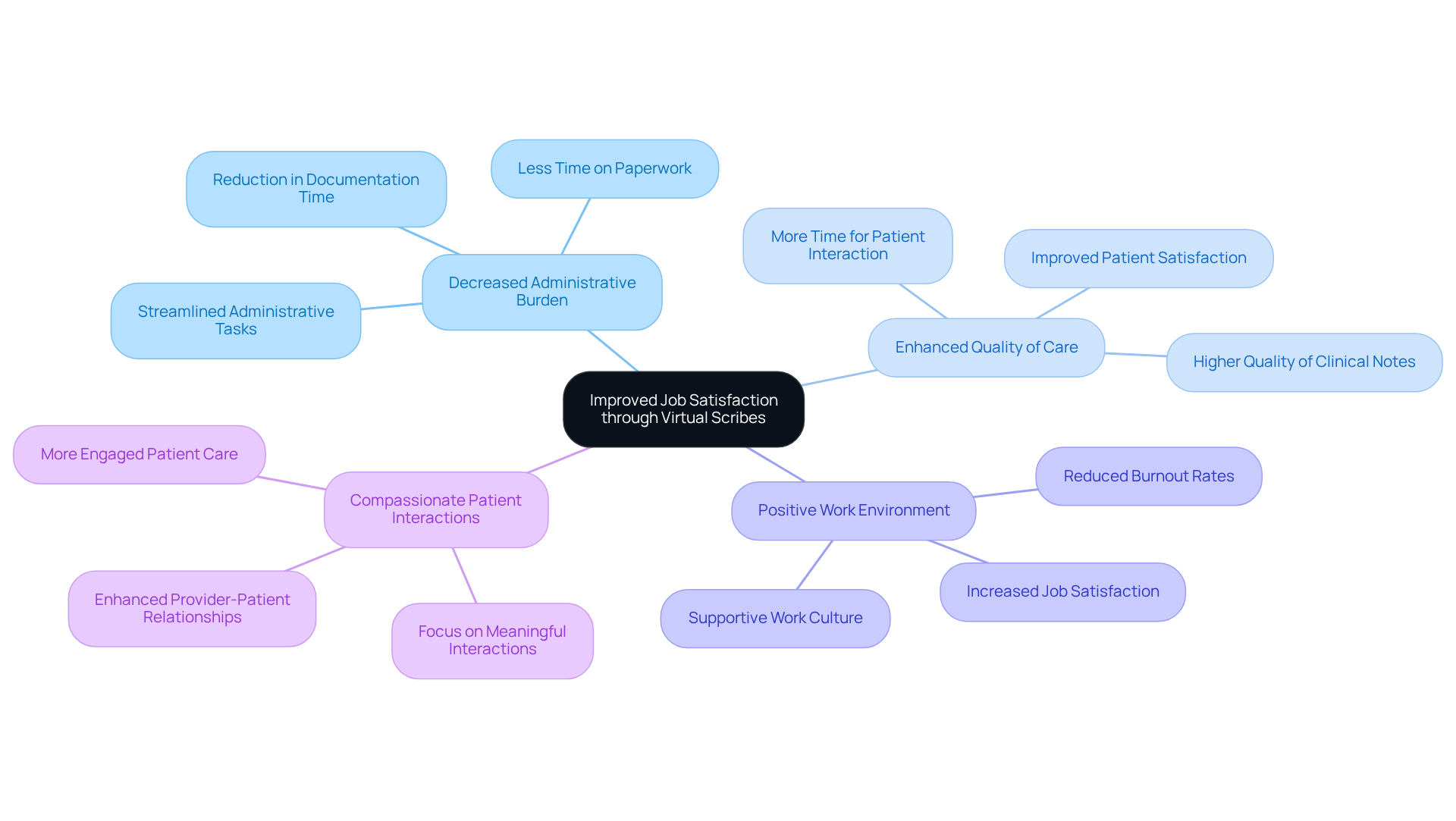
Enhanced Patient Experience: The Impact of Virtual Scribes on Care Quality
Virtual medical assistants are essential in enhancing the experience of individuals, allowing clinicians to engage more meaningfully during consultations. By taking on administrative tasks like scheduling and documentation, these clerks enable providers to focus on understanding client needs and nurturing relationships. This shift in focus has been shown to significantly boost client satisfaction. Research indicates that doctors who work alongside assistants have a 10.75 times higher likelihood of being satisfied with their clinic experience.
Moreover, individuals often feel more valued and heard, which is vital for delivering empathetic care. The presence of record keepers not only streamlines documentation but also enriches the quality of interactions, ultimately leading to improved health outcomes. As medical systems increasingly recognize the importance of clinician engagement in patient satisfaction, incorporating virtual assistants emerges as a vital strategy for enhancing care quality. It ensures that individuals receive the attention they truly deserve.
Consider how much smoother your practice could run with the support of a virtual assistant. Imagine the relief of having more time to connect with your patients, fostering a deeper understanding of their needs. With this approach, we can work together to create a where everyone feels seen and heard.
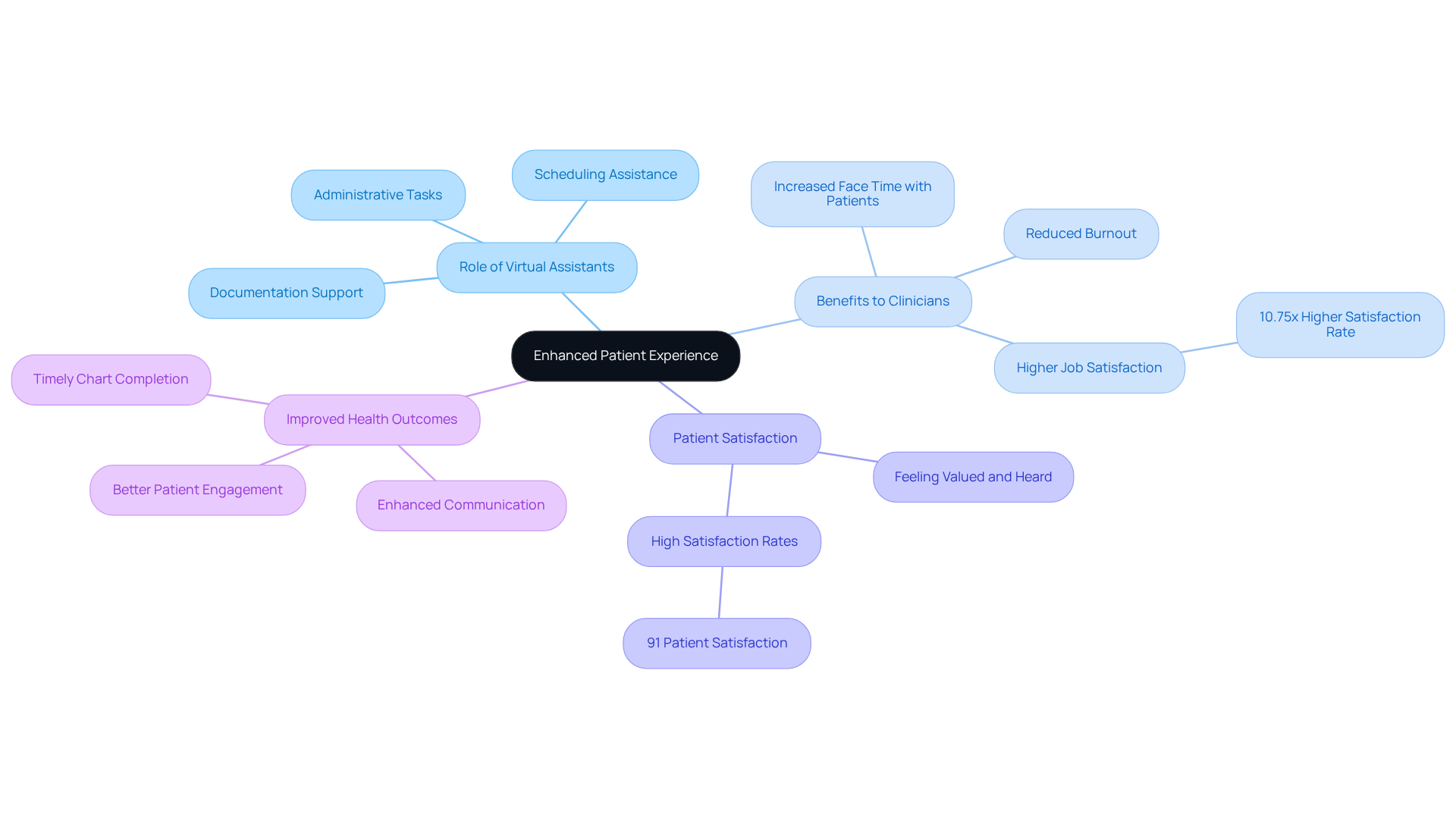
Scalability: Adapting Virtual Scribe Services to Meet Healthcare Demands
In the demanding world of healthcare, providers often face emotional challenges that can weigh heavily on their daily operations. Virtual physician scribes offer a compassionate solution through , providing exceptional scalability that allows medical practices to adjust their administrative support according to client volume and specific operational needs. As practices grow or experience fluctuations in patient numbers, virtual assistants can be seamlessly integrated to manage documentation tasks efficiently.
This adaptability not only enhances operational efficiency but also ensures that healthcare providers can maintain high-quality care, even amidst changing demands. Imagine the relief when methods employing digital assistants lead to significant reductions in time spent on documentation, allowing providers to focus more on meaningful interactions with those they care for.
Moreover, virtual physician scribes automate essential tasks such as appointment scheduling and medical record management, which directly alleviates physician burnout. The ability to scale services up or down as needed empowers practices to respond effectively during peak times, without the logistical challenges of adjusting physical staffing. In today’s dynamic medical landscape, where individual needs can shift rapidly, this flexibility is not just beneficial—it’s essential.
Consider how these solutions could transform your practice. By embracing virtual transcription services, you can foster an environment where both healthcare providers and patients thrive. Are you ready to explore how this compassionate approach can enhance your practice's efficiency and patient care?
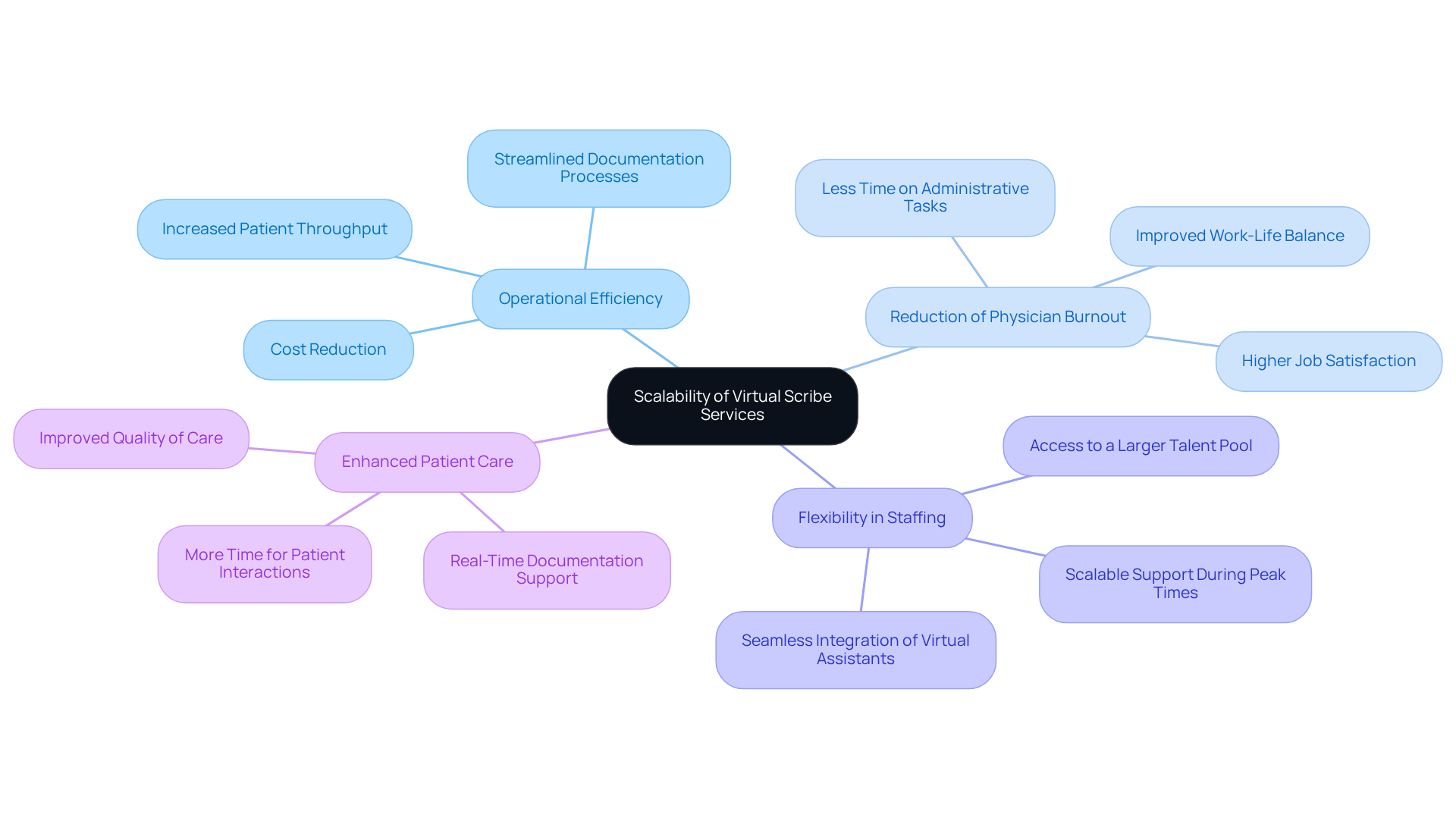
Ethical Considerations: Ensuring Compliance and Patient Confidentiality with Virtual Scribes
Integrating virtual medical assistants into medical practices presents emotional challenges, particularly concerning ethical issues like confidentiality and regulatory adherence. It’s essential for virtual physician scribes to receive comprehensive training on managing sensitive information, ensuring that all client data remains secure. By adhering to established ethical standards, medical providers can foster trust with their clients while effectively utilizing technology to enhance care delivery.
With the medical sector facing a troubling rise in data breaches—accounting for 79% of all reported incidents—maintaining becomes paramount. This commitment not only protects individual information but also fortifies the integrity of medical practices. As Peter Drucker wisely noted, "the quality of care is ultimately determined by the individual's perception and experience." Therefore, it is vital for suppliers to prioritize confidentiality and ethical practices in their operations, ensuring that every patient feels valued and safe.
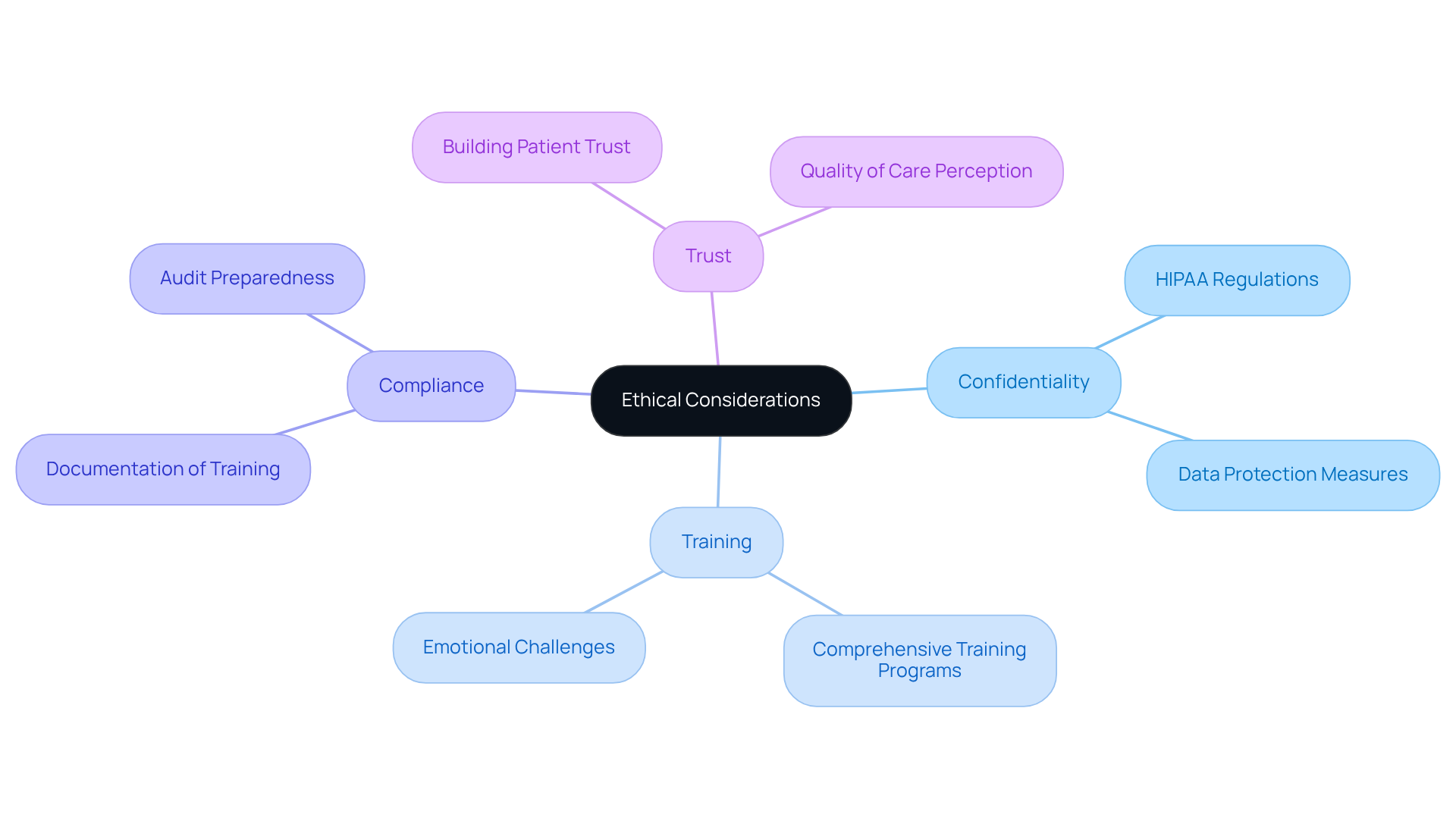
Revolutionizing Healthcare: The Comprehensive Impact of Virtual Physician Scribes
Virtual medical assistants are fundamentally by streamlining administrative tasks, enhancing documentation accuracy, and improving patient-provider interactions. Have you ever felt overwhelmed by the sheer volume of paperwork? By automating regular duties, these assistants greatly lessen clinician fatigue, allowing medical professionals to devote more time to direct patient care. In fact, studies indicate that physicians utilizing AI assistants report a remarkable increase in overall job satisfaction, with 82% noting enhanced work experiences due to reduced documentation burdens.
However, it is essential to acknowledge that a significant part of the medical field remains resistant to innovation. Many practitioners worry about preserving the quality of service and the personal touch in their interactions with patients. As the medical field continues to evolve, the incorporation of virtual assistants aligns with the growing trend toward patient-focused care. About 70% of patients using patient portals feel more connected to their medical providers, underscoring the importance of effective communication and engagement in enhancing health outcomes. Virtual assistants facilitate this connection, enabling physicians to focus on meaningful interactions rather than administrative tasks.
Real-world examples illustrate the profound impact of virtual assistants on healthcare delivery. For instance, a study involving 7,260 Permanente physicians revealed that those who frequently utilized AI scribes saved two and a half times more time per note compared to less frequent users. This efficiency not only enhances charting accuracy but also increases the likelihood of closing charts within 48 hours, which is crucial for timely patient data accessibility. By streamlining the workflow of medical providers, these enhancements can also help tackle challenges like rising expenses and limited access to services.
Looking ahead, the future of medical services with technology integration appears promising. Specialists emphasize that the use of virtual assistants is a vital approach to enhance medical efficiency and reduce physician fatigue. As the healthcare landscape embraces innovative solutions, virtual scribes will play an essential role in fostering a more compassionate, efficient, and ethical approach to patient care. How can we further support this transition and ensure that both patients and providers benefit from these advancements?
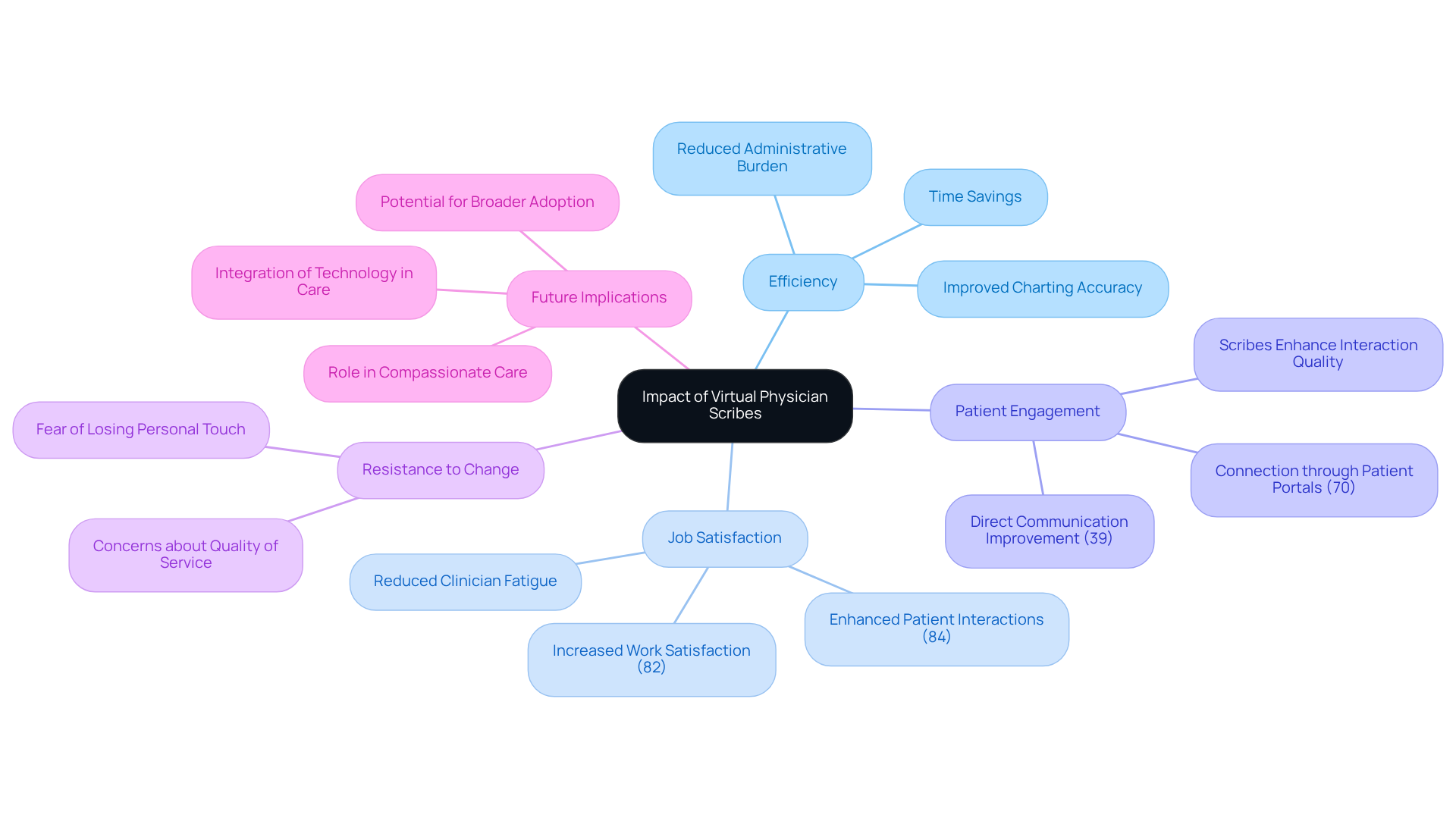
Conclusion
Embracing virtual physician scribes marks a significant transformation in healthcare, enabling providers to reclaim valuable time lost to administrative tasks. By integrating these AI-driven solutions, healthcare professionals can devote more attention to patient care, nurturing an environment that prioritizes individual needs.
The article underscores several essential benefits of virtual physician scribes, such as:
- Enhanced documentation accuracy
- Improved job satisfaction among healthcare providers
- Streamlined billing processes
These advantages not only simplify workflows but also contribute to better patient experiences and outcomes. Additionally, the scalability of virtual scribe services allows practices to adapt to changing demands while maintaining high-quality care.
As the healthcare landscape evolves, adopting virtual physician scribes becomes crucial for enhancing efficiency and alleviating clinician burnout. By focusing on innovative solutions that bridge the gap between administrative duties and patient interactions, healthcare providers can cultivate a more supportive and effective environment. The call to action is clear: embracing these advancements will not only benefit providers but will also ensure that patients receive the attentive, high-quality care they truly deserve.




